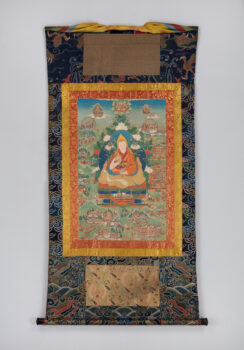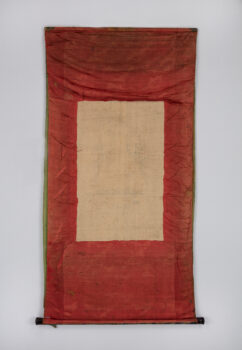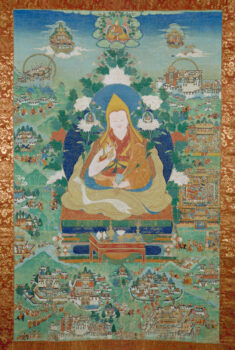U Region, Central Tibet
18th century
The hands form the shape of a wheel, symbolizing the “turning of the wheel of dharma,” a reference to teaching the Buddha’s doctrine.
U Region, Central Tibet
18th century



This exquisite painting tells the life story of Ngawang Lobsang Gyatso, the Fifth Dalai Lama (1617–1682). Renowned for unifying Tibet with Mongolian military backing in 1642. The Great Fifth, as he is known, was integral in the creation of a theocratic government led by the Dalai Lamas, which lasted until 1959.The story begins at the top left with his miraculous descent from the Potala pureland of the bodhisattva Avalokiteshvara into his mother’s womb at Chonggye Castle in southern U region, Tibet, highlighted by rainbow light. The biographical episodes continue counterclockwise, each vignette identified with a golden inscription, and include construction of Potala Palace (bottom left), his visit to the Qing Emperor Shunzhi (reigned 1644-1661) in Beijing in 1653 (center right), and end with his death at top right. This is labeled as the twelfth painting on the left, and thus the twenty-third painting in a very large set of lineage master depictions.
In Buddhism merit is accumulated through engaging in positive actions that lead to positive results, such as better rebirths. Buddhists gain merit by making offerings, donating to those in need, reciting mantras, and other good deeds.
The transmission of teachings from one generation to the next, from teacher to student, traced all the way back to the Buddha without interruption. A complete lineage is essential in Tantric Buddhist practices as it makes the blessings of the teaching more powerful.
Himalayan art includes portraits of legendary and historical humans, including accomplished religious teachers (lamas), the Buddha’s original disciples (arhats), and spiritually accomplished tantric masters (mahasiddhas).
Today, Tibetans primarily inhabit the Tibetan Plateau, situated between the Himalayan mountain range and the Indian subcontinent to the west, Chinese cultural regions to the east, and Mongolian cultural regions to the northeast. During the 7th to 9th century, Tibetan rulers expanded their empire across Central Asia, and established Buddhism as the state religion.
Get the latest news and stories from the Rubin, plus occasional information on how to support our work.